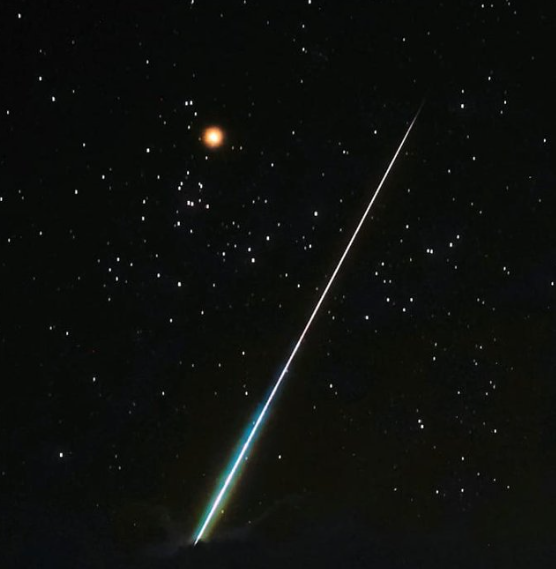August is bringing an array of stunning celestial events that are sure to captivate sky watchers. From the dazzling Perseid meteor shower to the year’s first supermoon and the return of aurora season, there’s plenty to look forward to this month.
Perseid meteor shower is active in August 2024. With clear skies, this phenomenon can be witnessed in our Andaman Night skies and one could also witness rings of Saturn and Moons of Jupiter alongwith other celestial bodies through powerful telescopes from #whistlingwoodsandaman pic.twitter.com/qoCtWXnqMn
— Udhay Bhasker (@UdhaybAndaman) August 2, 2024
August 4: New Moon
The new moon on August 4 provides the perfect conditions for stargazing. With no lunar illumination, the skies will be at their darkest, making it an ideal night to view the stars, especially from areas with minimal light pollution. This is also a great time to see the Milky Way core, which will become increasingly visible in the night sky as we approach late fall.
August 5: Crescent Moon Meets Venus
On the evening of August 5, look to the western horizon just after sunset to see Venus and the crescent moon close together. According to the SkySafari app, they will be visible for about an hour after sunset. Mercury will also be nearby, although it may be harder to spot without the aid of a telescope or binoculars.
August 11-13: Perseid Meteor Shower Peaks
The Perseid meteor shower, one of the most spectacular meteor showers of the year, will peak between August 11 and 13. The best time to see the meteors is overnight on August 12. In optimal conditions—clear skies and low light pollution—viewers can expect to see up to 100 meteors per hour. The Perseids, originating from the Swift-Tuttle comet, are known for their bright and colorful fireballs. The best viewing time will be after midnight, when the moon has set.
Happy August! 😎 Between the full Sturgeon Supermoon and the Perseid Meteor Shower, August’s night skies will give us plenty of reasons to LOOK UP (and dodge the hot sun!) Plus, find our favorite summer recipes that let your backyard corn, watermelon, and zucchini shine! And, of… pic.twitter.com/Cc4sPlgP7m
— Zeela Raj (@fastlane1944) August 1, 2024
August 14: Moon Joins Jupiter
On the morning of August 14, Mars and Jupiter will be visible together in the sky. They will appear closest to each other overnight, with Mars approaching Jupiter from the upper right. The best time to see them is around 2 a.m., looking towards the east-northeast horizon.
August 19: Supermoon
The year’s first supermoon will light up the sky on August 19. A supermoon occurs when the moon appears larger and brighter than usual due to its closer proximity to Earth. This month’s supermoon, also known as the full sturgeon moon, will be best viewed around sunset as it rises above the east-southeast horizon.
August 27: Moon Meets Mars and Jupiter
In the early morning hours of August 27, the crescent moon will form a triangle with Mars and Jupiter in the eastern sky. This trio will be visible near the Taurus constellation, with Betelgeuse, one of the brightest stars in the night sky, appearing below. The best time to see this celestial grouping is around 2 a.m., as they rise and continue to move eastward until sunrise.
August stargazing: Perseid meteor shower, supermoon, cool conjunctions https://t.co/AORJYKBTr8
— MLive (@MLive) July 31, 2024
August also marks the return of aurora season in far-northern regions such as Iceland and Alaska. This year could bring some of the brightest northern lights in decades, making it an excellent time for aurora chasing. For those interested in experiencing the northern lights, be sure to check out guides on how to best view and photograph these stunning natural displays.
Prepare your telescopes and cameras, and enjoy the incredible night sky events that August has to offer!
Major Points:
- The Perseid meteor shower will reach its peak between August 11 and 13, with up to 100 meteors per hour visible in optimal conditions.
- The new moon on August 4 offers the darkest skies for stargazing, perfect for viewing stars and the Milky Way core from locations with low light pollution.
- On August 5, the crescent moon and Venus will be visible close together just after sunset in the western horizon.
- The year’s first supermoon, also known as the full sturgeon moon, will occur on August 19, appearing larger and brighter than usual.
- Early on August 27, the crescent moon will form a triangle with Mars and Jupiter in the eastern sky, near the Taurus constellation.
Al Santana – Reprinted with permission of Whatfinger News

